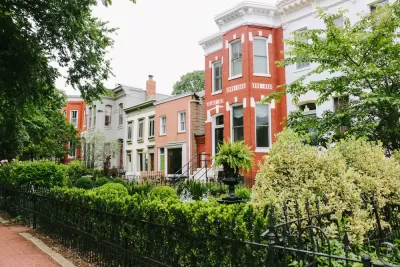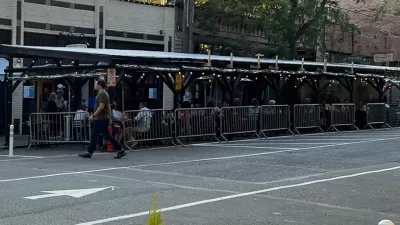A strongly worded opinion piece calls out historic preservation as a tool of the affluent urban elite.

Binyamin Appelbaum, a member of the editorial board of the New York Times, writes a criticism of historic preservation in the wake of a controversy about solar panels on historic homes in the historic district of Capitol Hill in Washington, D.C, where Appelbaum lives.
Here's how Appelbaum summarizes the conflict:
Humans don’t like change, so it’s not surprising that historic preservation laws have become quite popular. There are now more than 2,300 local historic districts across the United States, and I know many people who would like to have their own neighborhood frozen in time.
But historic preservation comes at a cost: It obstructs change for the better. And while that price is generally invisible, it is now on public display because of the city’s efforts to prevent Washington homeowners in historic neighborhoods from installing visible rooftop solar panels.
Appelbaum describes some of the very strict rules the Capitol Hill historic district has for alterations to homes in the area, and with some of these restrictions it shouldn't be hard to imagine that solar panels aren't welcome, even in the midst of climate change. An October controversy over a D.C. homeowner's petition to add solar panels created an uproar, leading to some changes that will make it easier to "a little easier to win permission to put solar panels on historic homes," according to Appelbaum, but "the fact that Washington continues to impose any aesthetic restrictions on rooftop solar panels is still a problem — and it is emblematic of the broader problems with preservation."
That problem, according to Appelbaum, has less to do with preserving history, and more to do with preserving "the lifestyle of an affluent urban elite."
FULL STORY: When Historic Preservation Hurts Cities

Planetizen Federal Action Tracker
A weekly monitor of how Trump’s orders and actions are impacting planners and planning in America.

San Francisco's School District Spent $105M To Build Affordable Housing for Teachers — And That's Just the Beginning
SFUSD joins a growing list of school districts using their land holdings to address housing affordability challenges faced by their own employees.

The Tiny, Adorable $7,000 Car Turning Japan Onto EVs
The single seat Mibot charges from a regular plug as quickly as an iPad, and is about half the price of an average EV.

With Protected Lanes, 460% More People Commute by Bike
For those needing more ammo, more data proving what we already knew is here.

In More Metros Than You’d Think, Suburbs are Now More Expensive Than the City
If you're moving to the burbs to save on square footage, data shows you should think again.

The States Losing Rural Delivery Rooms at an Alarming Pace
In some states, as few as 9% of rural hospitals still deliver babies. As a result, rising pre-term births, no adequate pre-term care and "harrowing" close calls are a growing reality.
Urban Design for Planners 1: Software Tools
This six-course series explores essential urban design concepts using open source software and equips planners with the tools they need to participate fully in the urban design process.
Planning for Universal Design
Learn the tools for implementing Universal Design in planning regulations.
Smith Gee Studio
City of Charlotte
City of Camden Redevelopment Agency
City of Astoria
Transportation Research & Education Center (TREC) at Portland State University
US High Speed Rail Association
City of Camden Redevelopment Agency
Municipality of Princeton (NJ)





























